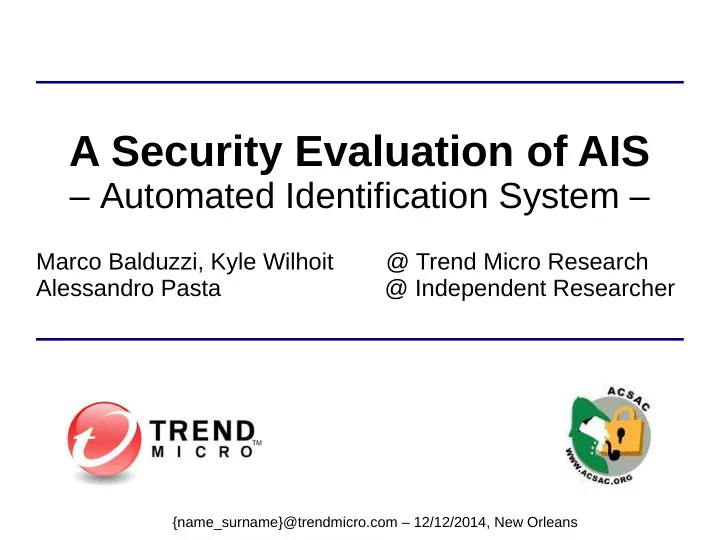

A Security Evaluation of AIS – Automated Identification System – Marco Balduzzi, Kyle Wilhoit @ Trend Micro Research Alessandro Pasta @ Independent Researcher {name_surname}@trendmicro.com – 12/12/2014, New Orleans
Automatic Identification System ● Tracking system for vessels – Ship-to-ship communication – From/to port authorities (VTS) ● Some applications: – Maritime security (against piracy) – Collision avoidance – Search and Rescue Operations / Accident investigations – Binary messages, e.g. Weather forecasting – Control messages from Authorities
Required Installation since 2002 ● Introduced to supplement existing safety systems, e.g. traditional radars ● Required on: – ANY International ship with gross tonnage of 300+ – ALL passenger ships regardless of size ● Estimated 400,000 installations ● Expected over a million
Exchange Format ● AIS messages are exchanged in 2 forms – Software: Online Providers – Radio-frequency (VHF): 162±0.25 MHz
Online Providers ● Collect and visualize vessels information ● Data collected via: – Mobile Apps / Software – Formatted emails – Radio-frequency gateways deployed regionally
Identified threats – 2 groups ● Implementation specific → AIS providers [SW] ● Protocol specific → AIS transponders [RF]
AIS Application Layer ● AIVDM messages, e.g.: – Position reports – Static reports – Management (channel...) – Safety-related (SART) ● NMEA format , as GPS !AIVDM,1,1,,B,177KQJ5000G?tO`K>RA1wUbN0TKH,0*5C TAG,FRAG_#,FRAG_ID,N/A,CHANNEL,PAYLOAD,[PAD],CRC
Example ● AIVDM_Encoder tool ● Ship involved in Military Operations ● MMSI 247 320162 (Italy)
Responsible Disclosure ● We did not interfere with existing systems ● We phisically connected our testing equipment ● Harmless and testing messages ● We reached out the appropriate providers and authorities within time (Sept. 2013) – MarineTraffic, AisHub, VesselFinder, ShipFinder – ITU-R, IALA, IMO, US Coast Guards
Software Evaluation
Spoofing – Online Providers [1/2] ● Ships, AtoNs, SAR Aircrafts ● Technically easy: TCP/IP or Emails
Spoofing – Online Providers [2/2] ● Make a ship follow a path over time ● Programmed with Google Earth's KML/KMZ information
Hijacking (MiTM) ● Via rogue (malicious) RF-gateway
Software-Hijacking ● “Move” a real ship – Eleanor Gordon
Popping Up in Dallas?
AIS protocol: A big mistake ● Designed in a “hardware-epoch” ● Hacking was difficult and cost expensive ● No security mindset – No authentication, no integrity check ● 2014: Craft AIS signals? ● Let's do it via software (SDR)! – Reduced costs and complexity – Increased flexibility ● Accessible to many. Including pirates!
AISTX ● Designed and implemented a software-based AIS transmitter based on GnuRadio
AIS Frame Builder Block
Radio-Frequency Evaluation
Testing Lab [1/2]
Testing Lab [2/2] ● Attacker [SX] – Victim [DX]
Spoofing in RF ● Example: static and dynamic reports for a ship
Trigger SOS ● Fake a "man-in-the-water" distress beacon ● Trigger SART (S.O.S.) alerts, visually and acoustically ● Mandatory by legislation ● Lure a victim vessel into navigating to a hostile and attacker-controller sea space
Trigger SOS
Trigger CPA alerts ● Fake a CPA alert (Closest Point of Approach) ● Trigger a collision warning ● Possibly alter course
Availability Disruption Threats
Frequency Hopping ● Disable AIS transponders ● Switch to non-default frequencies (RX/TX) ● Single or multiple target(s) ● Program a desired targeted region – Geographically remote region applies as well ● For example: Pirates can render a ship “invisible” upon entering Somalia
Frequency Hopping
Slot Starvation ● Disable AIS on a large-scale ● Impersonate port authorities to: – Fake a nearby base-station – Reserve all TDMA slots
Slot Starvation ● Step 1: Base-station spoofing
Slot Starvation ● Result: Target's Console
Timing Attack ● Instruct an AIS transponder to delay its transmission in time ● Default broadcast time: – Static reports = 6 min – Dynamic reports = 0.5 to 3 min (depending on speed) ● Attack code: –
Bonus (Additional Threats)
AIS as Attack Vector ● AIVDM messages are exchanged and processed at application layer by back-end software – In VTS server installations ● Binary message, special type used for – Crew members, Number of passengers – Environment information ● Malicious payloads, e.g. BOF, SQLi, …
AIS as Attack Vector ● SQL Error in back-end processing
Tampering with GPS ● Differential Global Positioning System (D-GPS) – Used by port authorities to increase the precision of traditional GPS (MTs → CMs) ● Attack = Spoof D-GPS beacons to force ships into calculating a wrong “GPS position”! – Message 17: GNSS broadcast binary message ● Related work “UT Austin Researchers Spoof Superyacht at Sea” – Monday, 29 July 2013
Proposed Countermeasures ● Anomaly Detection to data collected, e.g. by VTSs Detect suspicious activities, e.g. unexpected changes in vessels’ – route or static information. Correlate with satellite information to find incongruities – Works well, but does not protect agaist RF-specific threats – ● X.509 PKI: Digital certificates issued by official national maritime authorities Noteworthy stations' certificate (e.g., VTSs) pre-loaded via – onshore installations, e.g. when a ship enters a port Generic or previously unknown certificates are exchanged with – nearby stations on demand (i.e., vessels in navigation) Vessels with satellite Internet access can retrieve the certificates – from online services.
Take Home ● AIS is a major technology in marine safety ● AIS is widely used – mandatory installation ● AIS is broken at implementation-level ● AIS is broken at protocol-level ● We hope that our work will help in raising the issue and enhancing the existing situation!
Take Home ● AIS is a major technology in marine safety ● AIS is widely used – mandatory installation ● AIS is broken at implementation-level ● AIS is broken at protocol-level ● We hope that our work will help in raising the issue and enhancing the existing situation!
Thanks! Code available at: https://github.com/trendmicro/ais {name_surname}@trendmicro.com | @embyte
Recommend
More recommend